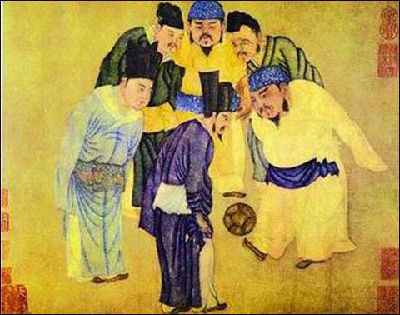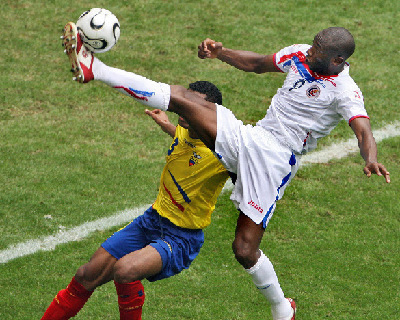Cuju, archetype of modern game of football
On July 15, 2004, Sepp Blatter, president of FIFA, formally announced to the world that soccer originates in Zibo, Shandong province, China. While maybe few people know that this sport is called Cuju in ancient China.
The game of cuju was first mentioned in the Zhan Guo Ce (under State of Qi's section) and later in the Sima Qian's Shiji (under Su Qin's biography), written during the Han Dynasty. Some claim that the Yellow Emperor invented the game for military training purposes, while others place its emergence during China's Warring States Period (476-221 BC). In any case, it certainly existed during this period. A competitive form of cuju was used as fitness training for military cavaliers, while other forms were played for entertainment in wealthy cities like Linzi.
|
 |
During the Han Dynasty (206 BC-AD 220), the popularity of cuju spread from the army to the royal courts and upper classes. It is said that the Han emperor Wu Di enjoyed the sport. At the same time, cuju games were standardized and rules were established. Football matches were often held inside the imperial palace. A type of court called ju chang was built especially for cuju matches, which had six crescent-shaped goal posts at each end.
The sport was improved during the Tang Dynasty (618-907). First of all, the feather-stuffed ball was replaced by an air-filled ball with a two-layered hull. Also, two different types of goal posts emerged: One was made by setting up posts with a net between them and the other consisted of just one goal post in the middle of the field. The Tang Dynasty capital of Chang'an was filled with cuju football fields, in the backyards of large mansions, and some were even established in the grounds of the palaces.[4] Soldiers who belonged to the imperial army and Gold Bird Guard often formed cuju football teams for the delight of the emperor and his court. The level of female cuju teams also improved. Records indicate that once a 17-year-old girl beat a team of army soldiers. Cuju football even became popular amongst the scholars and intellectuals, and if a courtier lacked skill in the game, he could pardon himself by acting as a scorekeeper.
Cuju flourished during the Song Dynasty (960-1279) due to social and economic development, extending its popularity to every class in society. At that time, professional cuju players were quite popular, and the sport began to take on a commercial edge. Professional cuju players fell into two groups: One was trained by and performed for the royal court (unearthed copper mirrors and brush pots from the Song often depict professional performances) and the other consisted of civilians who made a living as cuju players.
In the Song Dynasty only one goal post was set up in the center of the field. Cuju organizations were set up in large cities called Qi Yun She or Yuan She - now known as the earliest professional cuju club - whose members were either cuju lovers or professional performers. Non-professional players had to formally appoint a professional as his or her teacher and pay a fee before becoming a member. This process ensured an income for the professionals, unlike cuju of the Tang Dynasty. Ways to play cuju
There are mainly two ways to play cuju: "Zhu Qiu" and "Bai Da".
|
 |
"Zhu Qiu" was commonly performed at court feasts celebrating the emperor's birthday or during diplomatic events. This competitive match between two teams consisted of 12-16 players on each side.
"Bai Da" was the dominant cuju style of the Song Dynasty, attaching much importance to developing personal skills. The goal became obsolete in this method and the playing field was enclosed with thread, with players taking turns to kick the ball within. The number of fouls made by the players decided the winner. For example, if the ball was not passed far enough to reach the other players, points were deducted. If the ball was kicked too far out, a big deduction was made. Kicking the ball too low or turning at the wrong moment all led to fewer points. Players could touch the ball with any part of the body except their hands and the number of players ranged anywhere from two to 10. In the end, the player with the highest score would win.
Cuju began its decline during the Ming Dynasty (1368-1644) due to neglect, and the 2,000-year-old sport slowly faded away.
Cuju revival in modern China
Spring is the best period for playing Cuju. In current China, many people choose this game as a way to exercise while experiencing China's traditional culture.
A special game was recently held at Beijing World Park where some foreign visitors and locals dressed in traditional Han dynasty costumes played Cuju.
Many people believe Cuju is a good way to spread Chinese culture. Zhao Tong, a marketing manager at Beijing World Park, agrees.
"Cuju is the origin of modern football. China has great cultural resources, and we should promote them among many tourists through this platform. We hope that tourists will understand the history and development of Cuju through this activity, and we also hope that traditional Chinese culture can be passed down with the help of our volunteers."
As a way of national culture protection, Cuju was listed into the first batch of China’s intangible cultural heritages in 2006.
















